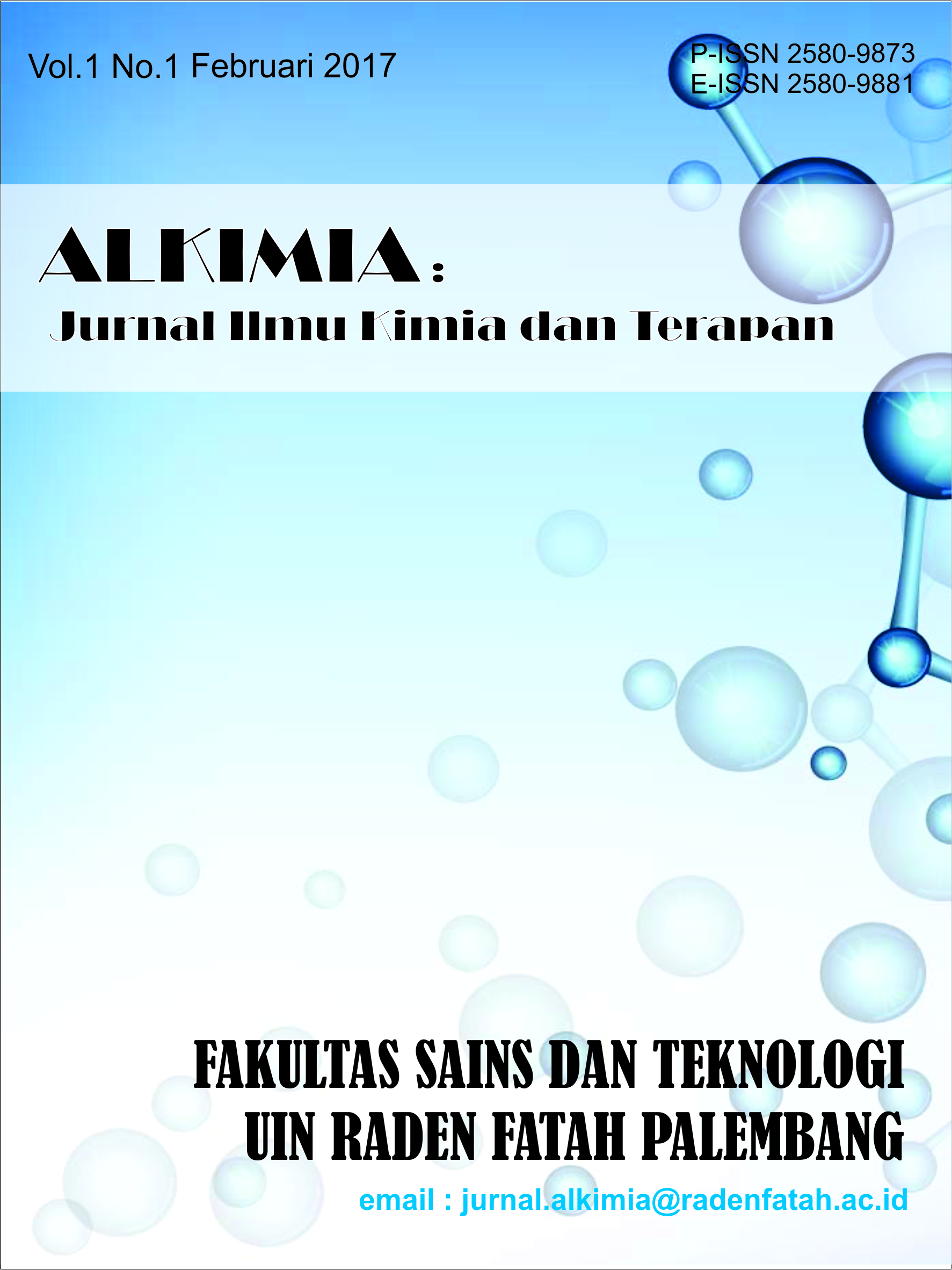Modified Glucomannan Derivative with p-Aminobenzoic Acid as Mild Steel Corrosion Inhibitor
DOI:
https://doi.org/10.19109/f3qcgh76Keywords:
glucomannan, p-aminobenzoic acid, corrosion inhibitor, mild steelAbstract
Indonesia's tropical climate, influenced by high temperatures and humidity, accelerates corrosion processes, especially in industrial and marine environments. Numerous studies have explored natural materials as corrosion inhibitors; however, most organic inhibitors suffer from poor thermal stability due to degradation of their chemical structures. This study aims to develop a heat-resistant and eco-friendly corrosion inhibitor using modified glucomannan from Amorphophallus onch (porang flour). The modification included using periodate oxidation to create an intermediate compound (GA-1), and then reacting it with para-aminobenzoic acid (pABA) to form a yellow-colored product. The synthesized compound was evaluated for its corrosion inhibition activity on mild steel in artificial seawater using various immersion times. At a concentration of 0.5 mg/L, the inhibitor exhibited an efficiency of 93.74% after 12 hours, decreasing slightly to 92.06% after 24 hours and 89.65% after 36 hours. The way it works is thought to be by the compound sticking to the steel surface, creating a protective layer that prevents harmful ions from interacting with the metal and slows down both the rusting of the metal and the reactions involving oxygen. These results indicate that the glucomannan–pABA derivative is a potentially effective eco-friendly corrosion inhibitor that can be used in tropical areas where corrosion is a problem.
References
R. Riastuti, “Corrosion never sleeps: Peristiwa korosi di sekitar kita. Orasi Ilmiah Guru Besar tetap dalam Bidang Korosi,” Univ. Indones. Depok, 2023.
X. Luo et al., “Dopamine modified natural glucomannan as a highly efficient inhibitor for mild steel: Experimental and theoretical methods,” Int. J. Biol. Macromol., vol. 242, 2023.
L. . Setyowati, G. Dimarzio, and D. . Astuti, “Aplikasi Ekstrak Kulit Buah Nanas sebagai Inhibitor Korosi Baja di Lingkungan NaCl 3,5%,” J. Chem. Process Eng., vol. 1, no. 2, pp. 39–44, 2020.
T. Nurahman, E. . Suka, and L. Rumiyati, “Pengaruh Konsentrasi Inhibitor Korosi Ekstrak Kulit Pisang Kepok (Musa paradisiaca L) terhadap Laju Korosi Baja Karbon API 5L pada Suhu perendaman 40℃ dan 80℃,” J. Teor. dan Apl. Fis., vol. 9, no. 2, pp. 133–142, 2021.
D. Samosir and S. Oko, “Proteksi Korosi pada Baja API 5L dengan Inhibitor Organik Ekstrak Daun Bawang Dayaj (Eleutherme americana Merr.) dalam Lingkungan HCl 0,5 M,” J. Tek. Kim. Vokasional, vol. 3, no. 1, pp. 1–7, 2023.
F. . Katingal, B. Purnomo, and F. Hilmy, “Potensi Ekstrak Kulit Buah Manggis sebagai Inhibitor pada Baja ST42 terhadap Laju Korosi dalam Media Air Laut,” Pros. Semin. Nas. Ris. dan Teknol. Terap., 2023.
Z. . Falah and N. Sylvia, “Pemanfaatan Tepung Glukomanan dari Pati Umbi Porang (Amorphophallus muelleri blume) sebagai Bahan Dasar Pembuatan Edible Film,” Chem. Eng. J. Storage, vol. 1, no. 3, pp. 50–62, 2021.
H. Afriyani, D. Herasari, H. Amrullah, Q.H. Faranida, M. Indriani, A. Ramadani, N.R.Afifah, K. Theledi, K. Aluko. Synthesis and Characterization of Edible Film Based on Glucomannan from Local Porang Tubers with a Combination of Carrageenan and Sorbitol as Plasticizer. Jurnal Biota, 10(2), 157-167, 2024.
X. Luo et al., “Synthesis of natural glucomannan derivative as a highly-efficient green inhibitor for mild steel in the simulated seawater,” J. Ind. Eng. Chem., vol. 124, pp. 132–146, 2023.
F. Wu et al., “Pattern of Specific Oxidation of Konjac Glucomannan with TEMPO/NaBr/NaClO system,” Carbohydr. Res., vol. 515, p. 108558, 2022.
Nurlela, D. Andriani, and R. Arizal, “Extraction of Glucomannan from Porang (Amorphophallus Muelleri Blume) Flour Using Ethanol,” J. Sains dan Terap. Kim., vol. 14, pp. 88–98, 2020.
W. Iftari, K. W. Astuti, E. Styani, A. Widyasmara, and C. Anwar, “Ekstraksi dan Karakterisasi Nano Glukomanan dari Umbi Talas (Colocasia esculenta L.),” War. Akab, vol. 47, no. 2, pp. 73–77, 2023.
I. Ismail, S. Budiman, F. Arkhaan, I. Nihati, I. Sepriyanata, and N. Afifah, “Gravimetric Determination Of Sulphate,” IJCC Indones. J. Chem. Connect., vol. 1, pp. 30–35, 2023.
A. Dehghani, A. H. Mostafatabar, G. Bahlakeh, B. Ramezanzadeh, and M. Ramezanzadeh, “Detailed-level computer modeling explorations complemented with comprehensive experimental studies of Quercetin as a highly effective inhibitor for acid-induced steel corrosion,” J. Mol. Liq., vol. 309, p. 113035, 2020.
C. P. Mungwari, B. A. Obadele, and C. K. King’ondu, “Phytochemicals as green and sustainable corrosion inhibitors for mild steel and aluminium: Review,” Results in Surfaces and Interfaces, vol. 18, p. 100374, 2025.
Downloads
Published
Issue
Section
License
Copyright (c) 2025 Hapin Afriyani, Ilim Ilim, Devi Nur Anisa, Dian Septiani Pratama, Qori Hikmah Faranida, Rekia Enrik

This work is licensed under a Creative Commons Attribution-ShareAlike 4.0 International License.
- The author saves the copyright and gives the journal simultaneously with the license under Creative Commons Attribution License which permits other people to share the work by stating that it is firstly published in this journal.
- The author can post their work in an institutional repository or publish it in a book by by stating that it is firstly published in this journal.
- The author is allowed to post their work online (for instance, in an institutional repository or their own website) before and during the process of delivery. (see Open Access Effect).







.png)




